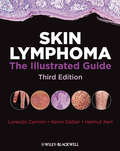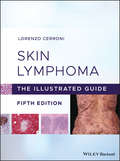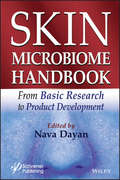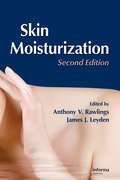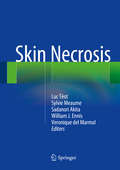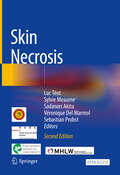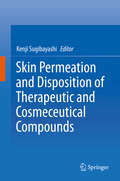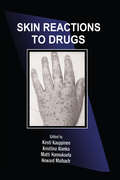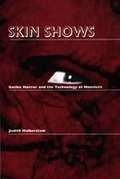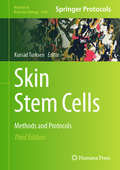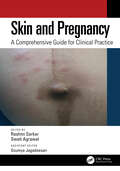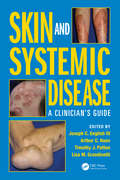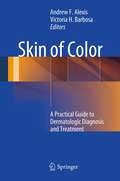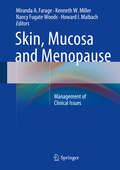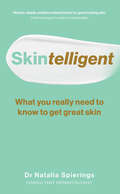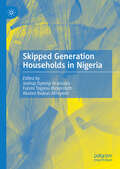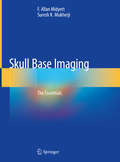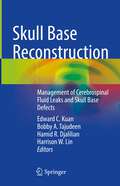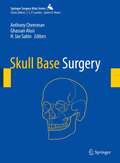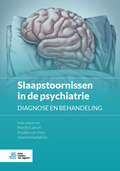- Table View
- List View
Skin Lymphoma: The Illustrated Guide
by Lorenzo Cerroni Kevin Gatter Kerl HelmutSkin lymphomas are relatively rare and can be easily misdiagnosed as psoriasis or dermatitis. These lymphomas can be fatal. Consequently, those in training in dermatology and pathology need to have a good understanding of the clinical presentations and the pathological correlates of this challenging disease. This updated edition provides: A full-colour illustrated text and atlas that combines pathology with clinical features and treatment updated nomenclature according to WHO/EORTC and WHO classifications Images to expand the diagnostic potential Cases to enhance the scope for teaching and learning
Skin Lymphoma: The Illustrated Guide
by Lorenzo CerroniA complete guide to the diagnosis and management of cutaneous lymphomas and pseudolymphomas Easily misdiagnosed as benign skin diseases, malignant cutaneous lymphomas can present a variety of challenges to trainees and practicing specialists alike. Skin Lymphoma: The Illustrated Guide has been designed to alleviate some of these difficulties, providing all those working in the dermatological field with a complete and easily consulted text on this potentially fatal cancer. Authored by renowned dermatopathologist Professor Lorenzo Cerroni, its exhaustive contents cover the clinical presentations and pathological correlates of cutaneous lymphomas in their various forms, alongside their prognoses and strategies for treatment. This expanded fifth edition features a wealth of enhancements and additions, including new chapters, updated content, and more than 1,300 full-color illustrations. Revised to reflect the most recent World Health Organization (WHO) and European Organization for Research and Treatment of Cancer (EORTC) classifications, its cutting-edge approach to its subject incorporates the latest molecular data, alongside more familiar histopathological and clinical features. The book’s considerable scope has been broadened into new and groundbreaking areas, the details of which are explored in chapters discussing primary cutaneous acral CD8+ T-cell lymphoma, composite lymphomas, and non-neoplastic cutaneous signs of systemic lymphomas, as well as in new sections on previously unexamined entities such as implant–associated anaplastic large cell lymphoma. Fully updated with new genetic data and most recent WHO classifications Contains four newly written chapters Features unconventional presentation sections with commentary on diagnosis Includes more than 1,300 color illustrations Skin Lymphoma: The Illustrated Guide is an indispensable resource forclinical dermatologists, dermatopathologists, and any other medical practitioners and trainees involved in the diagnosis and treatment of skin lymphomas.
Skin Manifestations in Rheumatic Disease
by Marco Matucci-Cerinic Daniel Furst David FiorentinoRheumatologic diseases are highly associated with clinical symptoms of the skin, nails, and mucosal membranes. This book provides the practicing rheumatologist with a rapid, easy to consult reference to help interpret the nature of these cutaneous lesions and then quickly decide upon the appropriate follow-up tests. Utilizing an abundance of informative photographs, it contains all of the essential information needed for early diagnosis and treatment. This comprehensive guide properly orients the practitioner within the challenging world of rheumatologic disorders of the skin and gives insight into when consultation with a dermatologist is advisable.
Skin Microbiome Handbook: From Basic Research to Product Development
by Nava DayanThe idea to compile and edit the book is the result of over a decade of work by the editor, Dr. Nava Dayan, on various projects related to skin barrier, innate immunity, microbiome, developing products, testing methods and paths of products to the market, both for pharmaceutical and the cosmetic industries. The book is a summary of current status of knowledge, research tools and approaches in skin microbiome, in health and disease. It contains the following categories: healthy skin microbiome and oral-skin interaction, skin microbiome observational research, skin microbiome in disequilibrium and disease, skin’s innate immunity, testing and study design, regulatory and legal aspects for skin microbiome related products. The 18 chapters of the book are written by carefully selected leaders in the academia, industry exhibiting extensive experience and understanding in the areas of interest.
Skin Moisturization (Basic and Clinical Dermatology)
by Anthony V. Rawlings James J. LeydenFocusing on the scientific basis of skin moisturization, this expanded Second Edition of Skin Moisturization explores a wide range of topics, from the biological aspects of the skin to the formulation of the active ingredients in skin moisturizers. Ideal for dermatologists, cosmetic scientists, and clinical scientists interested in the treatment of
Skin Necrosis
by Luc Téot Sylvie Meaume Sadanori Akita William J. Ennis Veronique MarmolIn recent years, wound care has gained increasing recognition as a distinct medical specialty. An understanding of the complex mechanisms involved in wound healing facilitates efficient assessment and treatment of patients with wounds, and skin necrosis can be considered the starting point in the entire healing process. This book is the first to discuss skin necrosis as a symptom related to a broad range of pathologies. Richly illustrated, it primarily provides therapeutic strategies and treatment algorithms for different clinical contexts. All chapters were written by renowned specialists in their respected fields and include detailed sample cases and essential take-home messages. In light of the highly interdisciplinary nature of wound management, Skin Necrosis offers an invaluable resource for wound care practitioners and health care professionals across the fields of surgery, dermatology, internal medicine, and nursing.
Skin Necrosis
by Luc Téot Sylvie Meaume Sadanori Akita Sebastian Probst Véronique Del MarmolThis successful book, now Open Access in its second edition, was the first to discuss skin necrosis as a symptom related to a broad range of pathologies. In recent years, wound care has gained increasing recognition as a distinct medical specialty. An understanding of the complex mechanisms involved in wound healing facilitates efficient assessment and treatment of patients with wounds, and skin necrosis can be considered the starting point in the entire healing process. Richly illustrated, this volume primarily provides therapeutic strategies and treatment algorithms for different clinical contexts, covering topics in distinct part: starting from definitions, physiopathology, vascular and imaging investigations, it then examines skin necrosis in its diverse clinical context, each assigned to a specific part: whether originated from physical injuries, of toxic origin, of medical or infectious nature, the content then shifts from the clinical context to the more specifically surgical context, and the application of existing techniques from dressing to debriding, including sharp and conservative ones. Dedicated sections deal with the pediatric and the elderly patients, closing the volume with a part on debridement education, from the perspective of the nurse and the physician, and finally a chapter on distance skin necrosis management, in the light of e-Health and personalized medicine. All chapters were written by renowned specialists in their respected fields and include detailed sample cases and essential take-home messages; the topics that require an in-depth approach are extensively covered, whereas clinical chapters are more essential, focusing on practicality. In light of the highly interdisciplinary nature of wound management, this new, updated edition of Skin Necrosis will be a much-valued tool for wound care practitioners and health care professionals across the fields of surgery, dermatology, internal medicine, and nursing.
Skin Permeation and Disposition of Therapeutic and Cosmeceutical Compounds
by Kenji SugibayashiThis book reviews skin permeation and disposition of chemical compounds. Skin is utilized as an administration site for transdermal drug delivery systems, topical drug formulations, cosmeceuticals, and cosmetics. Their usefulness is closely related to the permeation and disposition of entrapped active ingredients through and into the skin. Skin permeation, disposition, and metabolism of chemicals are first summarized in the general introduction. Then primary topical formulations are explained in the second part, "Basic Formulations Applied to Skin". The explanation for the active compounds and formulations are of the most important parts required to fabricate these formulations. Skin absorption of chemicals is generally much lower than oral and the other mucosal absorptions, so that skin-penetration enhancement is a key issue to have good formulations topically applied. Part 3 presents "Skin Penetration Enhancement". In addition, Part 4, "Selection of Topically Applied Chemical Candidates", deals with selection methods of topically applied ingredients for transdermal drug delivery systems, topical drug formulations, cosmeceuticals, and cosmetics. Parts 5 and 6, "Safety Assessment of Topically Applied Compounds" and "Experimental Methods of Skin Permeation", respectively, show safety issues and experimental methods for topical formulations. The final part consists of comments on therapeutic and cosmetic formulations by medical doctors and pharmacists. Their comments are especially helpful for pharmaceutical and cosmetic researchers who study dermatopharmacokinetics and topical formulations. This volume is particularly useful for those working in R&D, graduate students, and educators in the area of pharmaceutics, cosmetic sciences, dermatological sciences, pharmacology, toxicology, biopharmacy, pharmacokinetics, physical pharmacy, chemical engineering, and related fields.
Skin Reactions to Drugs (Dermatology: Clinical And Basic Science Ser. #15)
by Kirsti Kauppinen; Kristiina Alanko; Matti Hannuksela; Howard MaibachSkin reactions to drugs are a ubiquitous problem-the most commonly observed drug sensitivity observed in a wide range of specialties. Skin Reactions to Drugs emphasizes the mechanisms and clinical and laboratory proof of a cause-and-effect relationship between drugs and adverse reactions. It discusses the technique of drug challenge, which has been extensively developed in Finland, but not commonly practiced in the rest of the world. In this textbook, 12 of the most common drug eruptions are described both clinically and histologically. It features a chapter on systemic contact dermatitis and also addresses cutaneous adverse drug reactions that appear in HIV-infected patients. 40 full-color photographs provide vivid examples of the reactions being discussed. A highly practical resource for practicing physicians and other health care workers, Skin Reactions to Drugs represents the platinum standard of research conducted on the causation of certain adverse reactions of skin.
Skin Shows: Gothic Horror and the Technology of Monsters
by Judith HalberstamIn this examination of the monster as cultural object, Judith Halberstam offers a rereading of the monstrous that revises our view of the Gothic. Moving from the nineteenth century and the works of Shelley, Stevenson, Stoker, and Wilde to contemporary horror film exemplified by such movies as Silence of the Lambs, Texas Chainsaw Massacre, and Candyman, Skin Shows understands the Gothic as a versatile technology, a means of producing monsters that is constantly being rewritten by historically and culturally conditioned fears generated by a shared sense of otherness and difference.Deploying feminist and queer approaches to the monstrous body, Halberstam views the Gothic as a broad-based cultural phenomenon that supports and sustains the economic, social, and sexual hierarchies of the time. She resists familiar psychoanalytic critiques and cautions against any interpretive attempt to reduce the affective power of the monstrous to a single factor. The nineteenth-century monster is shown, for example, as configuring otherness as an amalgam of race, class, gender, and sexuality. Invoking Foucault, Halberstam describes the history of monsters in terms of its shifting relation to the body and its representations. As a result, her readings of familiar texts are radically new. She locates psychoanalysis itself within the gothic tradition and sees sexuality as a beast created in nineteenth century literature. Excessive interpretability, Halberstam argues, whether in film, literature, or in the culture at large, is the actual hallmark of monstrosity.
Skin Stem Cells: Methods and Protocols (Methods in Molecular Biology #2849)
by Kursad TurksenThis updated edition explores techniques in identifying and characterizing various skin stem cells and generating skin-like structures in vitro. The goal of the book is to present exciting advances in skin biology in an effort to provide a better understanding of skin and, eventually, to allow us to regenerate skin with its original form and function. Written for the highly successful Methods in Molecular Biology series, chapters include introductions to their respective topics, lists of the necessary materials and reagents, step-by-step and readily reproducible laboratory protocols, and tips on troubleshooting and avoiding known pitfalls. Authoritative and up-to-date, Skin Stem Cells: Methods and Protocols, Third Edition serves as a valuable assemblage of protocols for researchers already working in the field and for those who now wish to newly embark on studies of skin stem cells.
Skin and Pregnancy: A Comprehensive Guide for Clinical Practice
by Rashmi Sarkar Swati Agrawal Soumya JagadeesanThis text fills the gap between medical specialties in this topic, covering the dermatological diseases appearing during or affected by pregnancy; it also looks at safe drug usage and the cosmetic and aesthetic concerns of the pregnant woman. Most of the conditions discussed require a combined approach and treatment by the dermatologist and gynecologist and obstetrician, and this text establishes a united therapeutic approach for all practitioners. Fills the gap between the various specialties involved in managing skin diseases in pregnant patients Offers a unified approach for all health professionals managing pregnant patients Presents a practical and detailed clinical resource
Skin and Systemic Disease: A Clinician's Guide
by Joseph English III Arthur Huen Timothy Patton Lisa GrandinettiSkin and Systemic Disease: A Clinician's Guide acts as an essential clinical guide for health care providers during patient care. The opening chapter is based on skin findings that have numerous systemic associations, such as flushing or pruritus, providing clinicians with quick access to key information and illustrations pertaining to particular c
Skin and the Heart
by Carmen Salavastru Dedee F. Murrell James OttonThis book describes the relationship of the skin with cardiovascular disease. It details the variety of genetic, autoimmune, metabolic and endocrine factors that link the two disciplines. Recognition of one sign or symptom in dermatology can lead to the investigation and discovery of an important related cardiac condition, the recognition of which is important to prevent cardiovascular complications. Similarly, a cardiac condition may be related to an underlying skin condition that requires treatment.Genetic examples of such instances included within the book include: pseudoxanthoma elasticum, epidermolysis bullosa with desmosome defects and plectin defects; Marfan syndrome; Autoimmune conditions include vasculitis, sarcoidosis, lupus; metabolic conditions include insulin resistance, eruptive xanthomas with hypertriglyceridemias and elevated cholesterol; endocrine disorders include thyroid acropachy with atrial fibrillation; insulin resistance with coronary artery disease and psoriasis or hidradenitis suppurativa.Skin and the Heart reviews the effects of genetic, autoimmune and endocrine diseases with connections between skin and heart. It is therefore a key reference for all practitioners and researchers working in both disciplines.
Skin of Color
by Andrew F. Alexis Victoria H. BarbosaA concise practical guide to treatment and diagnosis of skin related disorders for skin of color patients.
Skin, Mucosa and Menopause
by Kenneth W. Miller Miranda A. Farage Howard I. Maibach Nancy Fugate WoodsAn era of global population aging is upon us. By 2030, one in eight people will be over age 65. Since women generally live longer than men, the health and welfare of postmenopausal women will become a significant public health concern. This book offers a comprehensive review of the life changes associated with menopause, both at the dermatological and physiological level (e. g. , hormonal, immunological) and at the subcellular level. It critically examines the dermatological, biological, and clinical challenges to postmenopausal health and well-being and the current and emerging therapeutic interventions. The authors advocate a holistic approach, emphasizing the need to view the menopause as a life transition with various facets rather than as a series of distinct medical conditions to be managed. Our goal is to offer a comprehensive resource to the researchers, clinicians, physicians, and helping professions whose mission is to promote the health and well-being of women around the world.
Skin: Delicious Recipes & the Ultimate Wellbeing Plan for Radiant Skin in 6 Weeks
by Liz EarleNourish, polish and perfect your skin from the inside out following beauty guru Liz Earle's amazing 6-week programme.Liz Earle is the authority on skincare and her brand new guide, SKIN, is the only book you will ever need to transform dull, lifeless skin, to skin that radiates youth and good health. SKIN features a 6-week programme to nourish your skin from the inside out. Each week focuses on a different aspect of skincare, from detox and exfoliation, cleansing and healing, to nourishing, balance and, finally, radiance and maintenance. It encourages you to incorporate new practices into your skincare routine such as body brushing and meditation, as well as guiding you through a make-up detox, making your own scrubs and masks and problem-solving for specific skin conditions.The programme is accompanied by 80 delicious and easy recipes to prove that what you put in your body is just as important for your skin as what you put on it. With breakfasts, lunches, easy suppers, snacks and desserts such as Banana and Nut Butter Pancakes, Salmon, Fennel and Quinoa, Rich Chocolate Pots and clever Beauty Bombs for an instant beauty hit, these recipes will help you on your way to glowing skin during the programme and beyond. All recipes are easy to make, don't need expensive or specialist ingredients and can be eaten all year round for glowing, radiant skin.
Skin: Delicious Recipes & the Ultimate Wellbeing Plan for Radiant Skin in 6 Weeks
by Liz EarleNourish, polish and perfect your skin from the inside out following beauty guru Liz Earle's amazing 6-week programme.Liz Earle is the authority on skincare and her brand new guide, SKIN, is the only book you will ever need to transform dull, lifeless skin, to skin that radiates youth and good health. SKIN features a 6-week programme to nourish your skin from the inside out. Each week focuses on a different aspect of skincare, from detox and exfoliation, cleansing and healing, to nourishing, balance and, finally, radiance and maintenance. It encourages you to incorporate new practices into your skincare routine such as body brushing and meditation, as well as guiding you through a make-up detox, making your own scrubs and masks and problem-solving for specific skin conditions.The programme is accompanied by 80 delicious and easy recipes to prove that what you put in your body is just as important for your skin as what you put on it. With breakfasts, lunches, easy suppers, snacks and desserts such as Banana and Nut Butter Pancakes, Salmon, Fennel and Quinoa, Rich Chocolate Pots and clever Beauty Bombs for an instant beauty hit, these recipes will help you on your way to glowing skin during the programme and beyond. All recipes are easy to make, don't need expensive or specialist ingredients and can be eaten all year round for glowing, radiant skin.
Skinny Bitch: A No-Nonsense, Tough-Love Guide for Savvy Girls Who Want To Stop Eating Crap and Start Looking Fabulous!
by Kim Barnouin Rory FreedmanNot your typical boring diet book, this is a tart-tongued, no-holds-barred wakeup call to all women who want to be thin.
Skintelligent: What You Really Need to Know to Get Great Skin
by Dr. Natalia SpieringsLearn how to navigate the confusing world of skincare so you never get fooled into buying hundreds of dollars of skincare products again with science- and evidence-based advice for healthy, great-looking skin from a world-renowned dermatologist.If you had a heart attack, would you go to a personal trainer to treat your chest pain? If you had cancer, would you seek treatment from a journalist who reviews chemotherapy drugs? No, you wouldn't. You would go to a cardiologist or an oncologist—an expert with vast clinical experience and knowledge. So why do we go to a beauty counter in a store or watch videos by beauty bloggers on YouTube to get skincare advice?Consultant dermatologist Dr. Natalia Spierings draws on a decade of work helping thousands of people achieve great skin by empowering you to navigate the confusing—and expensive—world of skincare. If you have a problem with your skin, it is a skin abnormality and cannot be corrected with a three-step skincare regime you buy at a department store.You'll learn:How skin worksHow skincare works (or doesn't)Unravelling big skincare ingredient claimsHow to treat the most common facial skin diseasesHow to tackle common aesthetic concernsThink of this book as your personal consultation with Dr. Spierings, and let her give you the information you need to start getting the best from your skincare—without hurting your wallet!
Skipped Generation Households in Nigeria
by Joshua Oyeniyi Aransiola Funmi Togonu-Bickersteth Akanni Ibukun AkinyemiThis volume unpacks the phenomenon of skipped generation households—where children live with their grandparents and without their parents—as they become an increasingly common family dynamic in Nigeria and globally. The skipped generation household's emergence in sub-Saharan Africa has been driven by factors including the HIV/AIDS epidemic, labour-based migration, and ethno-religious conflicts. By examining the data from a national study on skipped generation households in Nigeria, contributions track benefits, opportunities, and effects associated with growing up in these households. Details including academic performance and career aspirations for grandchildren, as well as social-psychological and physical well-being of both them and their grandparents, are explored.
Skull Base Imaging: The Essentials
by F. Allan Midyett Suresh K. MukherjiThis book is a comprehensive guide to skull base imaging. Skull base is often a “no man’s land” that requires treatment using a team approach between neurosurgeons, head and neck surgeons, vascular interventionalists, radiotherapists, chemotherapists, and other professionals. Imaging of the skull base can be challenging because of its intricate anatomy and the broad breadth of presenting pathology. Although considerably complex, the anatomy is comparatively constant, while presenting pathologic entities may be encountered at myriad stages. Many of the pathologic processes that involve the skull base are rare, causing the average clinician to require help with their diagnosis and treatment. But, before any treatment can begin, these patients must come to imaging and receive the best test to establish the correct diagnosis and make important decisions regarding management and treatment. This book provides a guide to neuoradiologists performing that imaging and as a reference for related physicians and surgeons. The book is divided into nine sections: Pituitary Region, Cerebellopontine Angle, Anterior Cranial Fossa, Middle Cranial Fossa, Craniovertebral Junction, Posterior Cranial Fossa, Inflammatory, Sarcomas, and Anatomy. Within each section, either common findings in those skull areas or different types of sarcomas or inflammatory conditions and their imaging are detailed. The anatomy section gives examples of normal anatomy from which to compare findings against. All current imaging techniques are covered, including: CT, MRI, US, angiography, CT cisternography, nuclear medicine and plain film radiography. Each chapter additionally includes key points, classic clues, incidence, differential diagnosis, recommended treatment, and prognosis. Skull Base Imaging provides a clear and concise reference for all physicians who encounter patients with these complex and relatively rare maladies.
Skull Base Reconstruction: Management of Cerebrospinal Fluid Leaks and Skull Base Defects
by Harrison W. Lin Edward C. Kuan Bobby A. Tajudeen Hamid R. DjalilianThis text, edited by two fellowship-trained rhinologists and two fellowship-trained neurotologists, represents an up-to-date comprehensive resource for any clinician or scientist involved in skull base reconstruction. Each chapter is written by a “super specialist” who has a clinical and/or academic focus in skull base pathologies and reconstruction. The first section is dedicated to basic principles, anatomy, physiology, imaging and anesthetic considerations. The second and third sections discuss pathological processes that lead to cerebrospinal fluid leaks and the need for skull base reconstruction within the anterior and lateral skull base, respectively. The fourth and fifth sections focus on anterior and lateral skull base reconstruction, respectively, with attention to reconstruction techniques and strategies for managing each defect type. The sixth section comprehensively reviews postoperative care and management strategies, where there is high variability and limited evidence, and is intended to present multiple perspectives that each carry merit. The final section highlights developments, research and emerging ideas regarding this ever-growing topic. Previous to this, there had been no book dedicated to this highly important and emerging topic that really challenges even the best of surgeons to this day. The intended audience of Skull Base Reconstruction includes skull base surgeons, otolaryngologists, neurosurgeons, neurologists, ophthalmologists, radiologists, emergency medicine physicians, trauma surgeons, and trainees and students in all of those areas.
Skull Base Surgery (Springer Surgery Atlas Series)
by Anthony Cheesman Ghassan Alusi H. Ian Sabin'Skull Base Surgery' represents genuinely multi-disciplinary collaborative approach to the standard procedures in skull base surgery. It emphasizes the basic operative steps of each approach and describes variations from the basic approach. Authors from the relevant specialties Neurosurgery, Otolaryngology, Maxillo-Facial Surgery and Plastic Surgery contribute to this new specialty of skull base surgery.
Slaapstoornissen in de psychiatrie: Diagnose en behandeling
by Marike Lancel Maaike Van Veen Jeanine KamphuisDit handboek biedt een overzicht van diverse slaapstoornissen, de diagnostiek en behandeling daarvan en hun relatie tot de psychiatrie en gebruik van psychofarmaca. Gezonde slaap is essentieel voor het functioneren van de hersenen. Slecht slapen is voorspellend voor het ontstaan van psychische klachten, voor de mate van remissie en het risico op terugval. Slaapstoornissen komen frequent voor bij vrijwel alle psychiatrische stoornissen en vormen één van de belangrijkste transdiagnostische symptomen.Slaapstoornissen in de psychiatrie gaat per psychiatrische aandoening uitvoerig in op de wisselwerking tussen psychiatrie en slaapstoornissen, waarbij epidemiologie, pathofysiologie en specifieke behandelmogelijkheden aan bod komen. Tot slot wordt aanvullend aandacht besteed aan zowel medicamenteuze en niet-medicamenteuze behandeling en aan enkele specifieke doelgroepen. Het boek geeft een verdiepend kader aan deze diagnose-overstijgende problemen, waarbij de theoretische achtergrond wordt geïllustreerd met praktijkvoorbeelden. Dit boek is bedoeld voor clinici, zoals psychiaters, psychologen, (huis)artsen en andere specialisten in de GGZ die zich willen verdiepen in de veelvuldig gemelde slaapproblemen bij mensen met een psychiatrische aandoening.Het boek staat onder redactie van prof. dr. Marike Lancel, drs. Maaike van Veen en dr. Jeanine Kamphuis, allen verbonden aan het Expertisecentrum Slaap en Psychiatrie, GGZ Drenthe.
